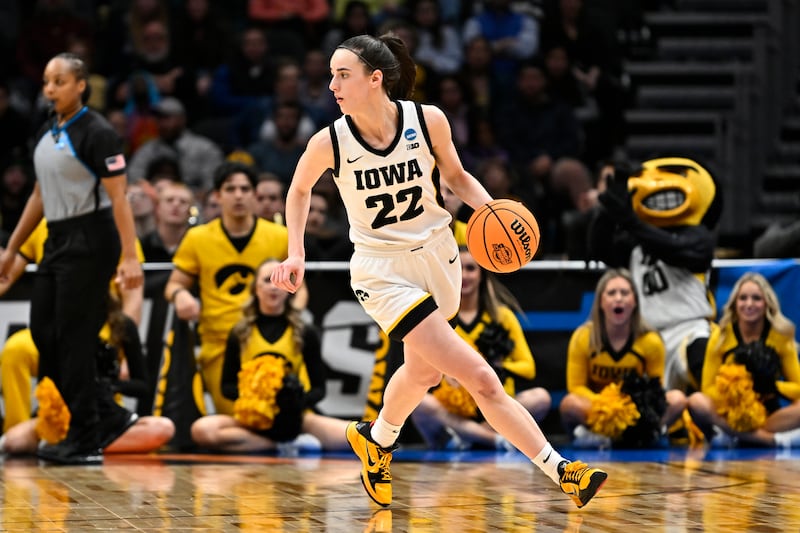In the early days of women’s high school and college basketball, the rules were very different from the male version of the sport.
Teams fielded six players each and adhered to very strict regulations. Two of them were restricted to the backcourt, two to the front, and the remaining pair entitled to roam freely.
Continuous dribbling was prohibited until 1966, sideline coaching only allowed two years later, and those running the game believed all this was necessary because girls weren’t capable of too much physical exertion and, at all costs, sweating was to be avoided as an unfeminine activity.
“Oh, I thought it was quite atrocious,” Peg Burke, a physical education teacher and basketball pioneer at the University of Iowa, told Michael MacCambridge for his wonderful new book, Big Time – How the 1970s transformed sport in America.
“It was such a limitation on girls – this idea that they couldn’t run the full length of the court without their womb dropping out, basically.”
Burke’s beloved Iowa Hawkeyes rolled into Jersey Mike’s Arena in Piscataway to take on Rutgers University on a Friday night earlier this month. A women’s college basketball match sold out the venue for the first time since 2006 and scalpers charged over $200 for tickets that normally retail for $17.
Eight thousand came from up and down the East Coast just to be able to say they saw the Iowa number 22 play in the flesh. One female fan wore a T-shirt that read, “My Roman Empire is Caitlin Clark”, skewing the recent TikTok meme that men allegedly think about the achievements of Augustus, Hadrian, Marcus Aurelius et al every day.

Clark is 6ft tall and 21-years-old, routinely described as the greatest women’s college player ever and already being spoken about as potentially the greatest female baller of them all.
Even in an era where recency bias comes as standard and exaggeration is the default setting, that’s a lot of expectation to be heaping upon a third level student. But the hyperbole is backed up by gaudy numbers. That she is the first woman to reach 3,000 points, 750 rebounds, and 750 assists illustrates how the record-breaking point guard from West Des Moines might just be the complete package, as adept at making scores for others as she is at notching them herself.
From Lisa Leslie to Chamique Holdsclaw to Breanna Stewart, there have been plenty of female phenoms over the past three decades but Clark is coming on stream, pouring in over 30 points a game, at a time when the sport has more eyes on it than ever before.
Television ratings are booming and interest in distaff basketball is such that there now exists Moolah, a putative rival to Adidas and Nike that designs boots just for women players. She’s also benefiting from the relaxation of ludicrous NCAA rules that once prevented college athletes from cashing in on their fame. As part of the NIL generation, she can make money from advertising her name, image, and likeness while still technically remaining an amateur.

One of her endorsement deals is with Hy-Vee, a midwestern grocery chain that put life-size cardboard cut-outs of Clark in stores last summer. Only for fans to steal them as souvenirs as fast as they appeared.
Last week, the same outfit started selling boxes of Caitlin Crunch Time cereal, all proceeds from which go to her charitable foundation set up to “uplift and improve the lives of youth through education, nutrition and sport”.
She can afford to be philanthropic because she earns nearly $1m a year through a blue-chip endorsement portfolio that includes Gatorade, State Farm Insurance, Nike, Buick, and Bose.
They all want a piece of somebody so box office her team drew 55,646 fans to an outdoor preseason game played at Kinnick Stadium, the university’s gridiron field, last October.
At the John Deere Classic Pro-Am back in July, she attracted the largest crowds of any celebrity since Bill Murray, and most of her gallery was young kids. When the Iowa Cubs, a minor league baseball team, announced a Caitlin Clark night where she was throwing out the ceremonial first pitch, fans started queuing 12 hours before the gates opened.

She grew up just over 120 miles from the campus where she is now garnering global attention for her extraordinary scoring feats.
Her father, a former college basketballer, realised she had a special talent for handling and shooting by the time she was four-years-old. Shortly after that, he signed her up for a boys’ team, and when she dominated one tournament, an opposing mother complained that it wasn’t fair, and the girl should not have been allowed to compete with the lads. By her early teens, she was inundated with offers of college scholarships and was on the radar of national media.
Whether or not Clark has a strong enough supporting cast to lead Iowa to a national championship this year (nearly 10 million tuned in to watch her score 30 points while losing the final last year), she will be picked number one in the WNBA Draft by the Indiana Fever in April.
Even though her presence will immediately fill arenas across the country, her starting salary in the pros will be $76,535. Every major company in America is desperate to be associated with her and will pay her what she’s worth. Except the league she’s about to light up. Women’s basketball. Work in progress.


















